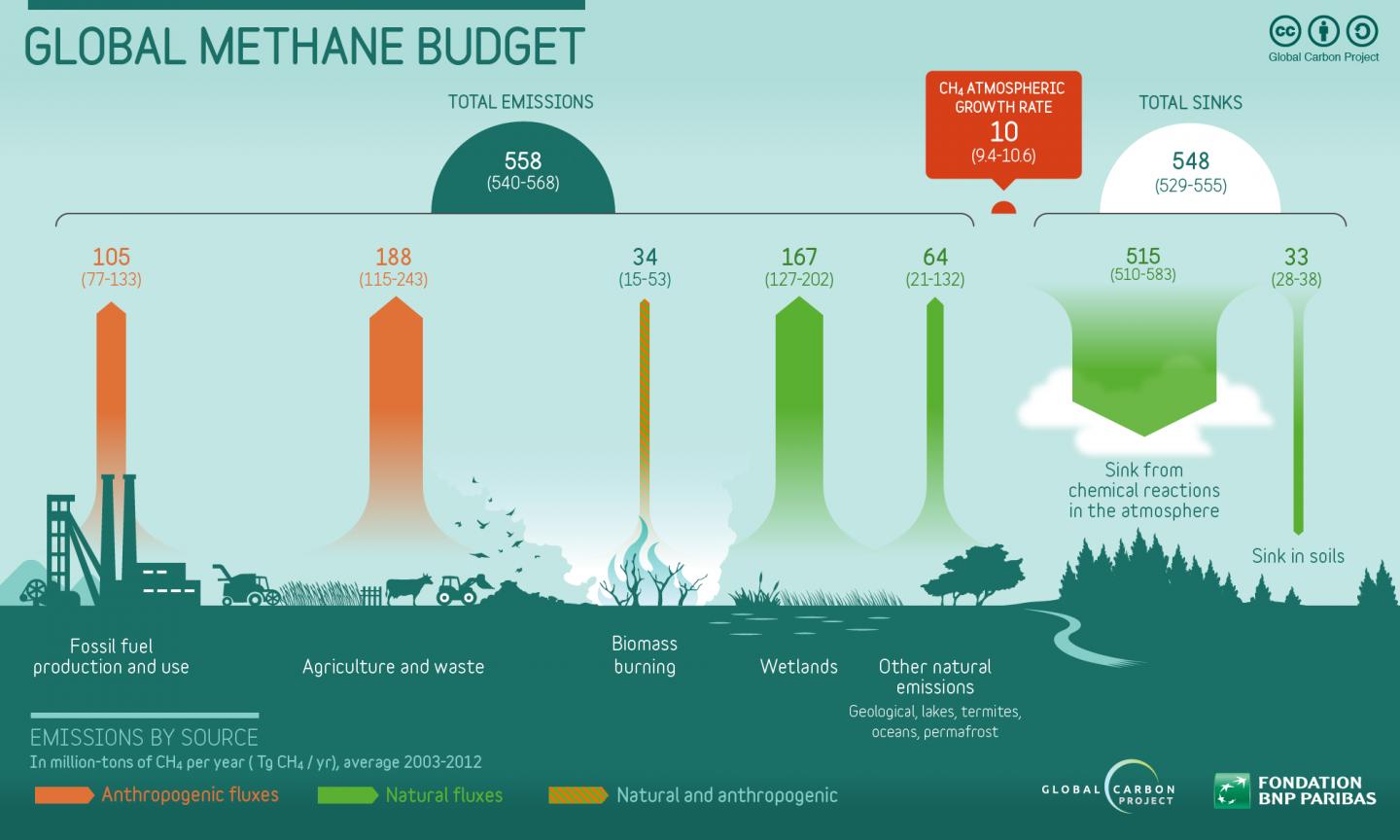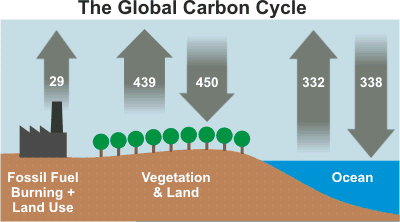The amount of Greenhouse Gas emitted by Livestock (
cows + sheep, pigs, chicken
etc...)
is more than all the world's cars, planes, boats & trains (18% vs
13%) :
 | Every year we raise and eat 65 billion animals, that's nine animals
for every person on the globe. |
 | Nearly a third of the Earth's ice-free land surface is already
devoted to raising the animals we either eat or milk. |
 | A single cow can belch up to 500 litres of methane every day.
Multiply that by the 1.5 billion cattle we have on our planet |
 | Methane is 28
times more potent a greenhouse gas than
carbon dioxide. |
 | 30% of the crops we grow are fed to animals. |
 | Meat consumption is predicted to double in the next 40 years as
people, globally, get wealthier. |
Intensively Reared vs Grass-Fed
A very different type of farming, thousands of cattle
confined in grass-free, mud enclosures and
fed a diet based on a carefully formulated mix of
corn, fat, growth hormones and antibiotics.
It looks the opposite of eco-friendly farming. Yet it is "greener" than
raising cows on the prairies - greater efficiency leads to less
environmental impact.
The scientifically formulated diet means cows put on weight faster and
produces 40%
less methane than grass-fed cattle.
Intensively reared, corn fed cattle may be the most environmentally
friendly.
On the other hand One of the big problems with grain-fed
livestock operations is the huge amount of land
that is used to produce grain. Approximately
80-90 million acres of land in the US are used to grow
corn alone. That is 80-90 million acres of
once native prairie that is now growing a
mono crop at a tremendous loss of biodiversity.
One of the major consequences of having cattle roaming the range is
soil compaction. There’s not a single study
that demonstrates that having a thousand pound cow trample soil is good
for the land.
Soil compaction
reduces water penetration, creating more
run-off and erosion. Because water
cannot percolate into the soil easily, soil compaction from cattle creates
more arid conditions—a significant problem in
the already arid West, but also an issue in the East since the soils are
often moister for a longer period of time. Moist soils are more easily
compacted. Sometimes the influence of pasture
grazing is long lasting. One study in North Carolina found that
stream insect biota were still significantly
different in streams heavily impacted by agriculture 50 years after
agricultural use had ceased compared to control streams. Soil compaction
also reduces the space in the top active layer of soil where most soil
microbes live, reducing
soil fertility.
source
If you really want to be environmentally friendly eat half the beef you
currently eat.
Plastic made from Methane
At the company’s research lab, methane gas—is mixed with air in a steel
tank.
Newlight’s patented biocatalyst then strips out the carbon from the
methane and chains the molecules together to form different grades of
plastic resin. At the end of the production line, the resin is chopped into
pellets. Newlight sells the pellets to manufacturers to be molded into
products. The company operates a plant in California and is building another
one in the Midwest that will produce 50 million pounds of plastic annually.
The company will obtain greenhouse gases from
landfills or farms.
Scientists are experimenting with creating an
AirCarbon
replacement for plastic water bottles and foam packaging,
those other ubiquitous scourges of modern life.
Dell says the computer maker next wants to use AirCarbon to replace foam
packaging and, eventually, plastic parts in its computers and servers. The
biggest challenge Newlight faces, he says, is scaling up production to meet
the demand of global corporations like Dell.
"Why would you ever use a plastic bag that emits carbon again?" "We
want to see this replace plastics everywhere." AirCarbon plastic is
biodegradable and
recyclable.
AirCarbon is an independently-verified,
cradle-to-grave (including all energy inputs, transportation, and
end-of-life) carbon-negative material,
quantifiably reducing the amount of carbon in the air in every ounce of
AirCarbon we make.
Source:http://www.bbc.com/news/science-environment-28858289
|
Livestock accounts for 9 per cent of CO2 deriving from human-related
activities, but produces a much larger share of even more harmful
greenhouse gases. It generates 65 per cent
of human-related nitrous oxide,
which has 296 times the Global Warming >Potential
(GWP) of CO2. Most of this comes from
manure.
And it accounts for respectively
37 per cent of all human-induced methane
(28 times as warming as CO2), which is largely produced by the
digestive system of ruminants, and 64 per cent of ammonia, which
contributes significantly to acid rain.
|
| Globally, over 60% of total
Methane (CH4) emissions come
from human activities.
Although our output of 29 gigatons of
CO2 is tiny compared to the 750 gigatons
moving through the
carbon cycle each year, it adds up
because the land and ocean cannot absorb all of the extra
CO2. About 40% of this additional
CO2 is absorbed. The rest remains in the
atmosphere, and as a consequence,
atmospheric CO2 is at its highest level in 15 to 20 million years (Tripati 2009). (A natural change of 100ppm normally
takes 5,000 to 20,000 years. The recent increase of 100ppm has taken
just 120 years).


Globally, about 40% of total N2O
emissions come from human activities.
Nitrous oxide is emitted from agriculture, transportation,
and industry. The impact of 1 pound of N2O on warming the
atmosphere is almost 300 times that of 1 pound of
carbon dioxide.
source
EPA |
|
|
March 2021:
Feeding cattle seaweed reduces their greenhouse gas emissions 82 percent
A bit of seaweed in cattle feed could
reduce methane emissions from beef cattle
as much as 82%, .... could pave the way
for the sustainable production of
livestock throughout the world. |
| |
2018
WORKING TOWARD SOLUTIONS: Methane
concentrations were stagnant for years up until a decade ago. And unlike
carbon dioxide, the bulk of methane emissions are human-driven. Chief among
those, according to the analysis, are agricultural sources such as
livestock, which emit methane through
bodily functions and manure, and rice fields, which emit methane when flooded.
Rising fossil fuel emissions play a secondary role compared to
agriculture for the global methane
increase.
Methane is 28 times more potent a greenhouse gas than
carbon dioxide but only lasts in the atmosphere 100 years versus
CO2's thousands of years. |
| |
Methane emissions from cattle are 11% higher than estimated |
| |
In 2014, methane concentrations rose 12.5 parts per billion,
compared to an annual rise of about 0.5 parts per billion a decade ago.
likely culprit is agriculture, especially in the tropics. |
| |
2016 study that claims feeding cows small amounts of
seaweed along with their normal diet of grass
can reduce methane emissions by up to 99% |
|
|
| |
California's Cow belching methane war SB1383
A Tax on meat or?
Veggy Burger Tech |
| |
 | One hamburger requires
660 gallons of water
to produce – the equivalent of 2 months’ worth of
showers. |
 | A farm with 2,500 dairy
cows produces the same amount of
waste as a city of
411,000 people. 130 times more
animal waste than human
waste is produced in the US |
 | 477 gallons of water are
required to produce 1 pound of eggs |
 | 55% of
water in the US is used for animal
agriculture, 80-90% for ALL Agriculture |
 |
Livestock and their byproducts account for
51% of all worldwide
greenhouse gas emissions. |
 | Fracking water use ranges from 70-140 billion,
Animal agriculture use ranges from 34-76
trillion, gallons annually. |
 | Land required to feed 1
Meat Eater is 6x
as much as a Vegetarian. |
 |
Livestock is responsible for 65% of
all emissions of nitrous oxide – a greenhouse
gas 296x more
destructive than carbon dioxide
|
Organic versus Conventional Farming,
a number of universities have established long-term trials over the
years. Between them all, we know that organic
agriculture:
 | is more profitable than, |
 | builds more soil fertility over time as
|
 | can yield just as much as |
conventional systems.
http://rodaleinstitute.org/our-work/farming-systems-trial/
|
|
